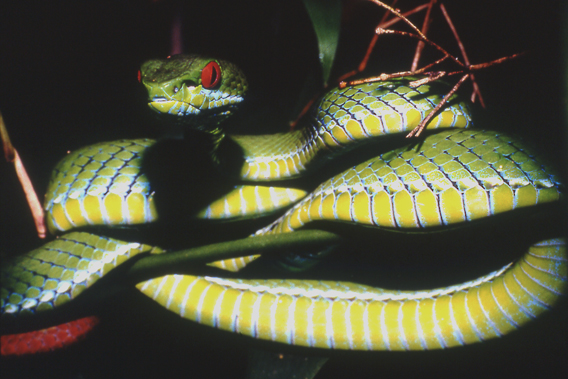
Hard to miss the bright red ruby eyes of the world’s newest pitviper: Cryptelytrops rubeus. Photo ©: Peter Paul van Dijk.
Researchers have discovered two new species of pitviper in Southeast Asia. After collecting snakes throughout the Asian tropics—Thailand, Laos, Vietnam, and Cambodia—researchers were able to parse out a more complex set of species than had been recognized. One of the new vipers has been dubbed Cryptelytrops rubeus for its ruby-colored eyes.
Over 12 years of work researchers conducted genetic tests, looked at physical differences, and then geographical separations of various viper populations that were all considered big-eyed pitviper (Cryptelytrops macrops). Out of the various population two new distinct species have been described: Cryptelytrops rubeus and Cryptelytrops cardamomensis.
“They are genetically distinct at mitochondrial and multiple nuclear genetic markers, and are geographically separated, occupying different mountainous areas […] There are some superficial differences involving the color of the eye, the presence and width of lateral stripes on the head and body and so on, but they are quite subtle,” co-author Anita Malhotra, a molecular ecologist at Bangor University, explained to mongabay.com.
Although little more is known about the behavior or status of the species in the wild, Malhotra says it is possible they are threatened.
“Depending on the species, the main threats are habitat destruction, and over-collecting (the vast majority of the latter is for traditional medicinal use, in some cases also for other purposes such as leather and the captive trade),” she told mongabay.com
Each of these pitviper species are poisonous and dangerous, although a bite is not usually fatal to humans.
The paper will appear in Zootaxa.
CITATION: Malhotra, A., R. S. Thorpe, Mrinalini and B. L. Stuart. 2011. Two new species of pitviper of the genus Cryptelytrops Cope 1860 (Squamata: Viperidae: Crotalinae) from Southeast Asia. Zootaxa 2757: 1–23.
Related articles
Biological shocker: snake reproduces asexually
(11/03/2010) Researchers have discovered a biological shocker: female boa constrictors are capable of giving birth asexually. But the surprise doesn’t end there. The study in Biology Letters found that boa babies produced through this asexual reproduction—also known as parthenogenesis—sport a chromosomal oddity that researchers thought was impossible in reptiles.
World’s rarest snake making a comeback

(11/02/2010) The Antiguan racer (Alsophis antiguae) shares a similar story with many highly endangered island species. Invasive mongoose killed every racer on the Caribbean island of Antigua, leaving only a small population on nearby Great Bird Island. Confined to 8 hectares, this final population was being killed-off by invasive Eurasian black rats. By the time conservationists took action, only 50 Antiguan racers survived in the world. But here’s where the story turns out different: 15 years later, a partnership between six conservation groups has succeeded in raising the population tenfold to 500 snakes and expanded its territory to other islands through snake-reintroductions.
Study points to global snake decline
(06/09/2010) A number of reports over the last decade have shown amphibians, lizards, fish, and birds facing steep population declines across species and continents, providing further evidence that the planet is undergoing a mass extinction. Now a new study in Biology Letters adds another group of animals to that list: snakes.